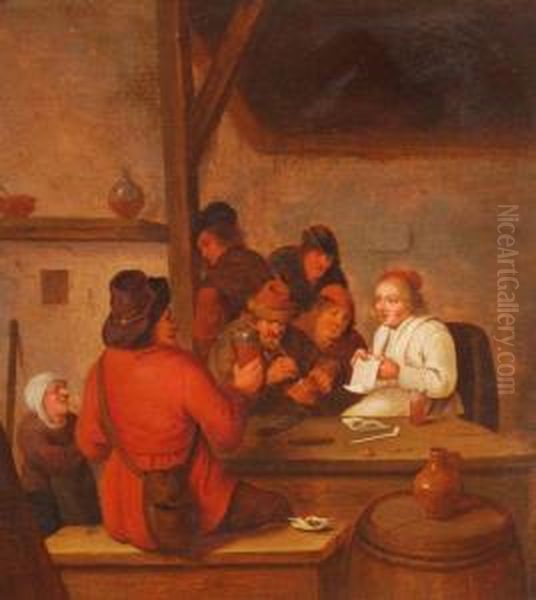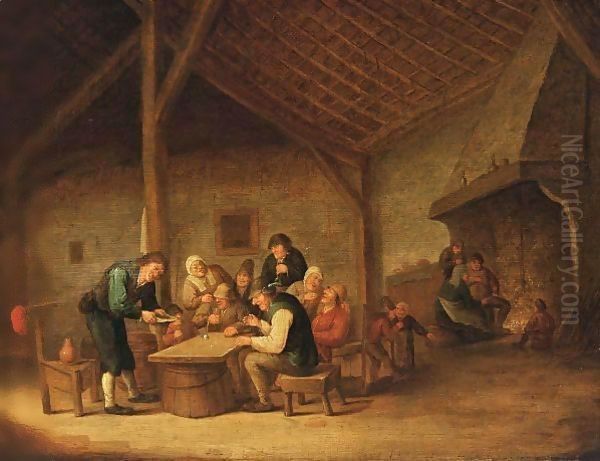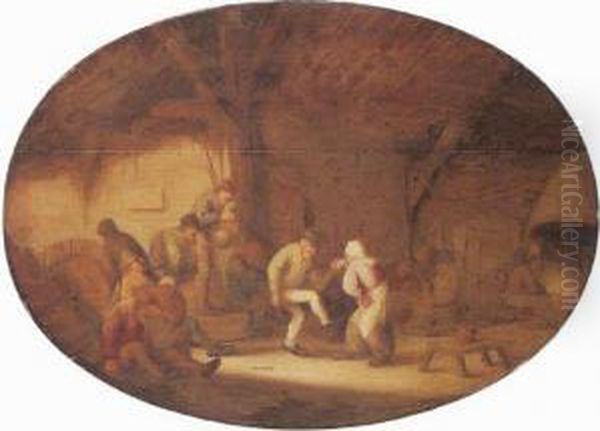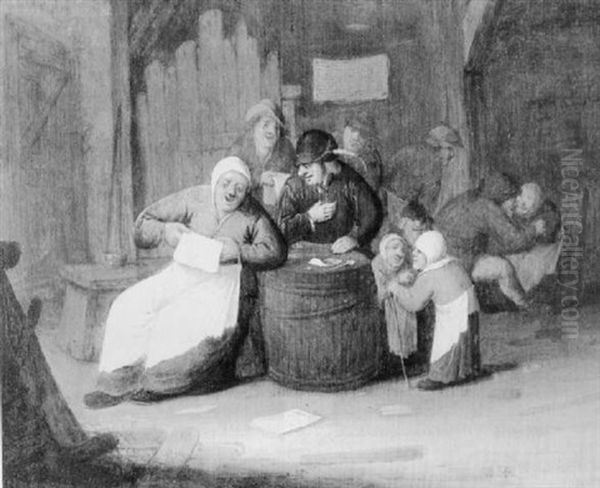Bartholomeus Molenaer stands as a notable figure within the bustling art scene of the Dutch Golden Age, particularly in the city of Haarlem. Active during the mid-seventeenth century, he specialized in genre painting, capturing vivid scenes of everyday peasant life. Though perhaps less renowned today than his elder brother, Jan Miense Molenaer, or his sister-in-law, Judith Leyster, Bartholomeus carved out his own niche, contributing a significant body of work that reflects the social fabric and artistic trends of his time. His paintings offer valuable insights into the interiors of taverns and cottages, populated by common folk engaged in leisure and daily activities.
Family Background and Haarlem Roots
Bartholomeus Molenaer was born in Haarlem around 1618. He hailed from a family with established roots in the city, though not initially in the arts. His father was Jan Mientensz. Molenaer, identified in records as a tailor, and his mother was Grietgen Adriaensdr. Bartholomeus was one of several children; significantly, his older brother, Jan Miense Molenaer (c. 1610–1668), became a highly successful and influential painter. Another brother, Claes Molenaer (c. 1630–1676), also pursued painting, focusing primarily on landscapes. This familial connection to the arts undoubtedly shaped Bartholomeus's path.
Growing up in Haarlem during the early 17th century placed Bartholomeus at the heart of a vibrant artistic center. The city was renowned for its painters' guild and fostered innovation in various genres, including portraiture, landscape, still life, and the genre scenes that would become the Molenaer family specialty. The presence of major figures like Frans Hals created a dynamic environment for aspiring artists. It is highly likely that Bartholomeus received his initial training within this stimulating milieu, possibly directly from his brother Jan Miense.
The Molenaer family network extended further into the art world when Jan Miense married Judith Leyster (1609–1660) in 1636. Leyster was herself a highly accomplished painter, known for her lively genre scenes and portraits. This union created a powerful artistic household, and it is probable that Bartholomeus worked closely alongside both his brother and sister-in-law, potentially sharing studio space and collaborating on works, a common practice at the time.
Artistic Training and Influences

While specific details about Bartholomeus Molenaer's formal training are scarce, his artistic development can be inferred from his style and professional milestones. His entry into the Haarlem Guild of St. Luke in 1640 is a key indicator of his establishment as an independent master painter. Membership in the guild was essential for legally selling artwork and taking on apprentices within the city. This step signifies that he had completed his training and achieved a recognized level of competence.
His primary influence was undoubtedly his brother, Jan Miense Molenaer. Their subject matter – peasant gatherings, tavern interiors, scenes of music-making and revelry – is remarkably similar. Both brothers often depicted figures with expressive, sometimes caricatured features, capturing moments of boisterous energy or quiet domesticity. However, art historians often note subtle differences, suggesting Bartholomeus's handling might be somewhat broader or less refined in detail compared to the meticulous finish often seen in Jan Miense's work.
Beyond his brother, Bartholomeus's style shows affinities with other Haarlem genre painters. The influence of Adriaen van Ostade (1610–1685), another Haarlem master of peasant scenes, is palpable. Both artists shared an interest in depicting the rustic interiors of taverns and cottages, often using a warm color palette and paying attention to the effects of light and shadow (chiaroscuro) to create atmosphere. Some of Bartholomeus's works, particularly earlier ones, might also echo the dynamism and looser brushwork associated with the towering figure of Haarlem art, Frans Hals (c. 1582–1666), although Hals focused primarily on portraiture. The broader tradition of Flemish genre painting, particularly the work of Adriaen Brouwer (1605–1638), who worked for a time in Haarlem, also provided a backdrop for Molenaer's chosen themes.
Style and Subject Matter
Bartholomeus Molenaer dedicated his relatively short career primarily to genre painting, focusing on scenes of lower-class life. His canvases are typically populated by peasants, farmers, and townspeople depicted in familiar settings: dimly lit taverns, rustic cottage interiors, and occasionally outdoor scenes related to village life. These settings provided ample opportunity to explore themes of leisure, social interaction, and the simple pleasures or hardships of everyday existence in the 17th-century Dutch Republic.
His most characteristic works feature tavern interiors. These scenes often depict groups of men (and sometimes women) engaged in various activities – drinking beer from earthenware jugs, smoking clay pipes, playing cards or board games, engaging in animated conversation, or listening to musicians. Molenaer excelled at capturing the convivial, sometimes rowdy, atmosphere of these establishments. He arranged his figures in dynamic groupings, using gestures and facial expressions to convey interaction and mood.

Molenaer's approach was generally realistic, aiming to provide a believable glimpse into these environments. He paid attention to the details of clothing, furniture, and domestic objects – wooden stools, barrels, cooking implements, and the ubiquitous jugs and pipes. His use of light often plays a crucial role, typically focusing on the central figures while leaving the corners of the room in shadow, enhancing the sense of intimacy or enclosure. His color palette tends towards earthy tones – browns, grays, ochres, and muted reds and greens – appropriate for the rustic settings he portrayed. While similar to Jan Miense, Bartholomeus's brushwork can sometimes appear quicker and more robust.
Key Works and Representations
Several paintings exemplify Bartholomeus Molenaer's typical style and subject matter. While titles can vary and attribution between the Molenaer brothers is sometimes debated, certain works are consistently associated with him. Tavern Interior is a recurring theme, and multiple versions exist. One notable example, often cited, might be the Interior of a Tavern housed in the Frits Lugt Collection (Fondation Custodia) in Paris. Such works typically show a group of peasants gathered around a table, drinking and smoking, perhaps with a fiddler providing entertainment, all rendered with Molenaer's characteristic attention to rustic detail and atmospheric lighting.
Another significant work mentioned in records is Peasants Drinking in an Inn. One painting with this theme, formerly in the Russian Imperial collection (Hermitage, St. Petersburg), was transferred to the Omsk Museum of Fine Arts in Siberia in 1927. This provenance highlights how works by even secondary masters like Molenaer circulated among prominent collections across Europe. These paintings serve as valuable documents of social history, illustrating customs, attire, and the material culture of the Dutch lower classes.
Other common subjects include scenes of peasants playing cards, families gathered in cottage interiors, and sometimes more specific activities like visiting the dentist (a theme also explored by other genre painters). While perhaps lacking the psychological depth or refined technique of the very top masters, Molenaer's works possess a directness and vitality that effectively conveys the spirit of his subjects. His contribution lies in consistently producing these engaging snapshots of 17th-century life.
Professional Life and Collaborations
Bartholomeus Molenaer's professional life unfolded within the established structures of the Haarlem art world. His acceptance into the Guild of St. Luke in 1640 marked his official entry into the profession. This membership allowed him to operate independently, sign and sell his works, and potentially take on pupils, although no records of apprentices under his direct tutelage are known. His career appears to have been centered entirely in Haarlem.

The close proximity to his brother Jan Miense and sister-in-law Judith Leyster suggests a collaborative working environment. It's highly probable that they shared studio resources and perhaps even assisted each other on commissions or larger projects. The stylistic similarities, particularly between Bartholomeus and Jan Miense, further support the idea of a shared workshop practice. Distinguishing their individual hands in unsigned works or collaborative pieces remains a challenge for art historians.
Haarlem in the 1640s was a competitive market. Besides the established giants like Hals and the prolific Ostade brothers (Adriaen and Isack), numerous other talented painters vied for patronage. Figures like Cornelis Bega (c. 1631–1664), who also specialized in peasant genre scenes, and later Jan Steen (c. 1626–1679), who worked in Haarlem for periods, were part of this landscape. Landscape painters such as Salomon van Ruysdael (c. 1602–1670) and the great Jacob van Ruisdael (c. 1628–1682) added to the city's artistic prestige, as did still-life masters like Pieter Claesz (c. 1597–1660) and Willem Claesz. Heda (1594–c. 1680). Molenaer operated within this rich, diverse, and demanding artistic community.
Personal Life and Financial Situation
In 1641, a year after joining the guild, Bartholomeus Molenaer married Cuyniera Hendriksdr. (also spelled Hendricx or Hendricxs). The couple went on to have four children who survived infancy: Frans, Johan (sometimes recorded as Joris or Jan), Maria, and Claes. This established family life coincided with his active period as a painter.
However, archival evidence suggests that Bartholomeus faced significant financial difficulties, a common plight for many artists even during the prosperous Golden Age. An inventory of his possessions was drawn up shortly before his death in September 1650. Such inventories were often compiled in cases of debt or impending death. Crucially, this document revealed outstanding debts, including unpaid rent owed to his landlady, Maritge Claesdr. The inventory also noted that his studio space was located within his mother's kitchen, suggesting modest living and working conditions.
Bartholomeus Molenaer died relatively young, around the age of 32. He was buried in Haarlem on September 19, 1650. His early death cut short his artistic career and likely contributed to his lesser fame compared to his longer-lived brother Jan Miense. His financial struggles underscore the precarious nature of the art market, where talent did not always guarantee prosperity. His widow, Cuyniera, was left to manage the debts and care for their young children.
Contemporaries in Haarlem and Beyond

Understanding Bartholomeus Molenaer's place requires situating him among his contemporaries. In Haarlem, the dominant figure was Frans Hals, whose innovative portraiture influenced many. Within genre painting, his closest connections were his brother Jan Miense Molenaer and sister-in-law Judith Leyster. Adriaen van Ostade was a major force in peasant scenes, and his brother Isack van Ostade (1621–1649) also contributed significantly to the genre before his early death.
Adriaen Brouwer, though Flemish, spent crucial years in Haarlem and Amsterdam, profoundly impacting Dutch genre painting with his raw depictions of peasant brawls and tavern life. His influence can be seen indirectly in the work of many Haarlem artists, including the Molenaers and Ostades. Cornelis Bega followed in this tradition, often depicting similar themes. Later, Jan Steen, known for his lively and often moralizing scenes, spent important formative years in Haarlem.
The city was also a center for landscape painting, led by figures like Salomon van Ruysdael and his nephew, the celebrated Jacob van Ruisdael. Though working in a different genre, their presence contributed to the city's artistic reputation. Still-life painting flourished with masters like Pieter Claesz and Willem Claesz. Heda, known for their 'ontbijtjes' (breakfast pieces). While Molenaer did not engage in these genres, the sheer diversity and quality of art produced in Haarlem formed the competitive and stimulating environment in which he worked. Other less famous contemporaries included painters like Nicolaes de Kemp and Pieter van der Eyst, the latter noted as being influenced by Bartholomeus Molenaer's interior scenes.
Legacy and Art Historical Standing
In the grand narrative of Dutch Golden Age art, Bartholomeus Molenaer occupies a position as a competent and productive master within the Haarlem school, but one overshadowed by more famous contemporaries, including members of his own family. His primary contribution lies in his consistent production of genre scenes depicting peasant life, particularly tavern interiors. These works offer valuable visual records of 17th-century Dutch society and customs among the lower classes.
His relative obscurity compared to Jan Miense Molenaer or Judith Leyster can be attributed to several factors. His career was significantly shorter due to his early death. He appears to have produced fewer works overall, and perhaps fewer ambitious or large-scale compositions. Furthermore, genre painting, especially scenes of "low life," while popular, was often considered lower on the artistic hierarchy than history painting or elite portraiture during the period itself and in subsequent art historical evaluations.
Attribution issues also complicate his legacy. The similarity in style and subject matter between Bartholomeus and Jan Miense has led to confusion, with works sometimes being misattributed between the two brothers. A lack of consistent signatures on all his works further compounds this problem. Consequently, establishing a definitive catalogue raisonné for Bartholomeus remains challenging.
Despite these factors, his work is represented in various museum collections and appears periodically on the art market. He is recognized as a distinct artistic personality within the Molenaer circle and the broader Haarlem school. Artists like Pieter van der Eyst show his direct influence. For specialists in Dutch genre painting, Bartholomeus Molenaer remains a figure of interest, representing the solid craftsmanship and thematic concerns typical of many artists working outside the absolute top tier during this incredibly rich artistic period.
Conclusion
Bartholomeus Molenaer was a dedicated painter of peasant life, contributing actively to the vibrant art scene of 17th-century Haarlem. Born into an artistic family, he followed his brother Jan Miense into the field of genre painting, specializing in lively and atmospheric depictions of tavern and cottage interiors. He joined the Guild of St. Luke in 1640 and maintained a career focused on these popular themes, influenced by his brother and contemporaries like Adriaen van Ostade.
Despite facing financial difficulties and dying young around the age of 32, Molenaer produced a body of work characterized by its earthy realism, dynamic figure arrangements, and effective use of light and shadow. While often compared to his more famous brother, Bartholomeus developed his own recognizable, albeit related, style. His paintings, such as the various Tavern Interiors, serve as important visual documents of everyday life in the Dutch Golden Age. Though not ranked among the foremost masters, Bartholomeus Molenaer holds a secure place as a skilled representative of the Haarlem school and a chronicler of the common folk of his time.